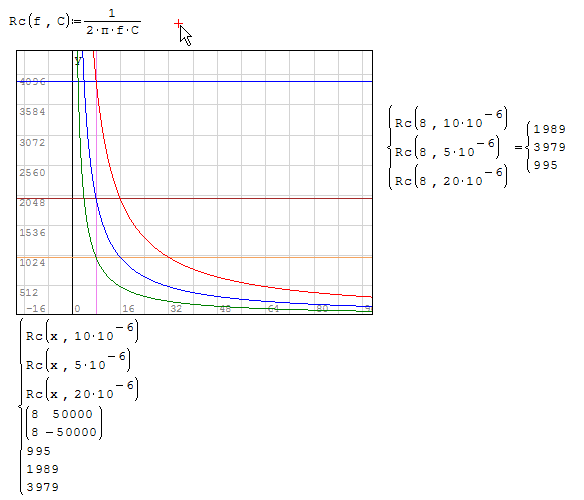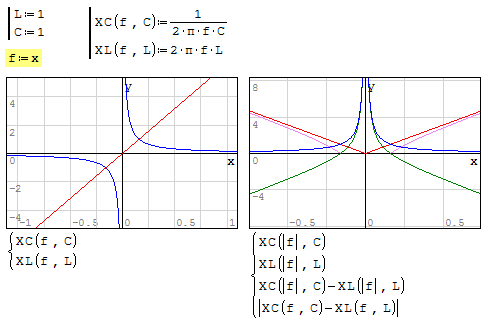Operation with units: f is not defined - Messages
#1 Posted: 6/24/2016 7:13:55 PM
#2 Posted: 6/24/2016 9:39:49 PM
Hi Basile.
That's is the expected way to work with smath.
To get the value of X.C you must to call the function after defining X.C with X.C(f)=
Best regards.
Alvaro.
That's is the expected way to work with smath.
To get the value of X.C you must to call the function after defining X.C with X.C(f)=
Best regards.
Alvaro.
#3 Posted: 6/24/2016 10:34:38 PM
Alvaro,
Look to the left the of X.C , the X.L
Should behave the same?
Basile
Look to the left the of X.C , the X.L
Should behave the same?
Basile
#4 Posted: 6/24/2016 11:02:38 PM
#6 Posted: 6/25/2016 12:46:19 AM
Same problem as before: you have no circuit, then no LC project.
The only thing you can do is calculate the resonance frequency: 'fo'
Then plot it as sin(fo)
The only thing you can do is calculate the resonance frequency: 'fo'
Then plot it as sin(fo)
#7 Posted: 6/25/2016 9:41:27 AM
Jean,
I am calculating the reactance of the inductor and the capacitor at a frequency f.
Basile
I am calculating the reactance of the inductor and the capacitor at a frequency f.
Basile
#8 Posted: 6/25/2016 1:53:44 PM
In my times, pure L, C were strictly imaginary. Just by themselves they don't have much use
whereas there is no such thing as pure L , pure C. They both have physical resistiviy.
whereas there is no such thing as pure L , pure C. They both have physical resistiviy.
#9 Posted: 6/25/2016 6:30:56 PM
Jean,
You are right that:
X.L=jωL
and
X.C=-j(1/ωC)
and the magnitude is that I calculate.
You can simply consider ideal elements without the loss resistance.
Basile
You are right that:
X.L=jωL
and
X.C=-j(1/ωC)
and the magnitude is that I calculate.
You can simply consider ideal elements without the loss resistance.
Basile
#10 Posted: 6/25/2016 9:51:28 PM
Hi Basile. That's isn't.
Correct XL and XC (reactances) are without j, as in your worksheets.
ZL and ZC (impedances) are with j.
Actually the total impedance is Z = R + jX, where X = XL + XC is the total reactance.
Best regards.
Alvaro.
Correct XL and XC (reactances) are without j, as in your worksheets.
ZL and ZC (impedances) are with j.
Actually the total impedance is Z = R + jX, where X = XL + XC is the total reactance.
Best regards.
Alvaro.
#11 Posted: 6/26/2016 12:35:47 AM
Alvaro,
You are confusing things.
What you say are correct but have to do nothing to do with the question.
X.L, X.C are reactance (with j or without j)
Z is impedance of R and X.
Basile
You are confusing things.
What you say are correct but have to do nothing to do with the question.
X.L, X.C are reactance (with j or without j)
Z is impedance of R and X.
Basile
#12 Posted: 6/26/2016 1:03:00 AM
WroteAlvaro,
You are confusing things.
What you say are correct but have to do nothing to do with the question.
X.L, X.C are reactance (with j or without j)
Z is impedance of R and X.
Basile
Hi Basile. I don't confusing. Reactances ( https://en.wikipedia.org/wiki/Electrical_reactance ) are reals and impedances ( https://en.wikipedia.org/wiki/Electrical_impedance ) are complexes. So X.L, X.C can't have j.
About the numerical evaluation for a function, check this old post: http://en.smath.info/forum/yaf_postst640_Function-as-a-program.aspx
In X.L, X.C definitions as functions, f must to be a local variable. X.L(f) -> (symb evaluation) must to set the answer with "f", not with "100 Hz". And the numerical evaluation X.L(f) = must to be in red, as f as local variable isn't defined.
As a choice of the program writer, and what you can see in the last post of the above referenced, you can set all the local variables as globals with f(x) = 1*(line ... ). Actually I'm not comfortable with that behavoir, but is the choice of Andrei.
Best regards.
Alvaro.
#13 Posted: 6/26/2016 2:01:29 AM
#14 Posted: 6/26/2016 2:59:10 PM
#15 Posted: 6/26/2016 7:42:21 PM
#16 Posted: 6/27/2016 12:00:18 AM
#17 Posted: 6/27/2016 10:15:28 AM
#18 Posted: 6/27/2016 10:17:47 AM
Note that I have removed the unit system because
"Units don't match" error mesage ... so: zap !
"Units don't match" error mesage ... so: zap !
#19 Posted: 6/27/2016 11:03:08 AM
Jean,
"why units do not match? Are they both Ω?"
Basile
PS: Thank you for the discussion.
"why units do not match? Are they both Ω?"
Basile
PS: Thank you for the discussion.
#20 Posted: 6/27/2016 1:54:29 PM
Redefining subtraction or function.

Best Regards
Carlos
test resonance_CBG.sm (10.1 KiB) downloaded 613 time(s).

Best Regards
Carlos
test resonance_CBG.sm (10.1 KiB) downloaded 613 time(s).
- New Posts
- No New Posts



